Chrysanthemum tea fruit jellies are elegant, floral-infused desserts that combine the delicate flavor of chrysanthemum tea with the sweetness of fruit. You'll create these light and revitalizing treats by steeping dried chrysanthemum flowers, then mixing the tea with gelatin and fruit juice. They're not only delicious but also offer health benefits, being rich in antioxidants and supporting eye health. To make these jellies, you'll need chrysanthemum flowers, clear fruit juices, and a gelling agent like gelatin or agar-agar. Serve them chilled for a sophisticated palate cleanser or a unique dessert. There's an art to perfecting these jellies, from selecting complementary fruits to mastering the molding process.
What Are Chrysanthemum Tea Jellies?
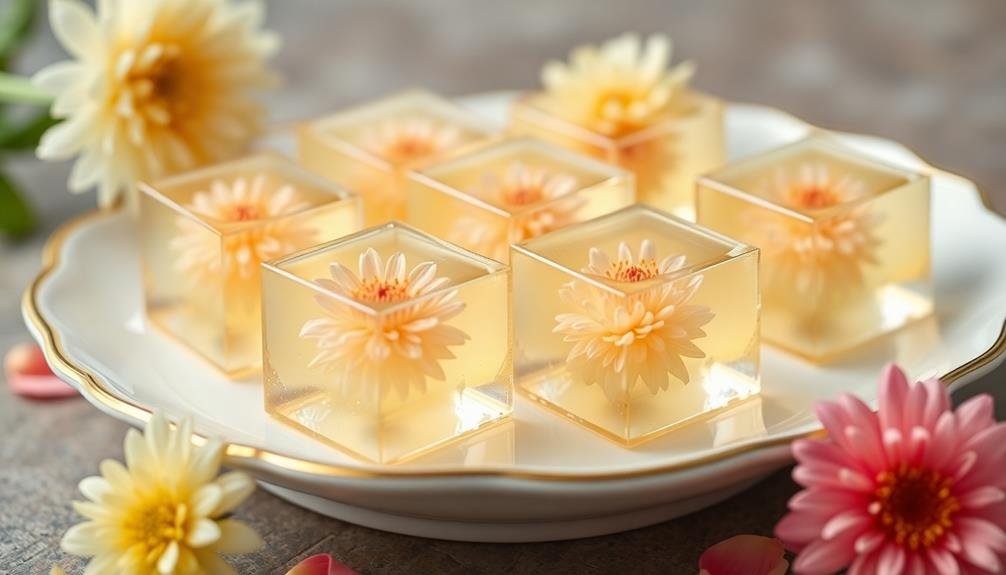
Chrysanthemum tea jellies are delicate, floral-infused treats that combine the subtle sweetness of chrysanthemum tea with the bouncy texture of fruit jelly.
These elegant desserts are made by steeping dried chrysanthemum flowers in hot water to create a fragrant tea, which is then mixed with gelatin and fruit juice to form a translucent, wobbly jelly.
You'll find these jellies to be light and invigorating, with a delicate floral aroma that's not overpowering. They're often served chilled, making them perfect for warm summer days or as a palate cleanser after a rich meal.
The addition of fruit juice enhances the natural sweetness of the chrysanthemum tea, creating a harmonious blend of flavors.
In Asian cuisine, particularly Chinese and Korean, chrysanthemum tea jellies are popular as both a dessert and a medicinal treat.
They're believed to have cooling properties and are sometimes consumed to alleviate symptoms of heat-related illnesses.
You can enjoy these jellies on their own or pair them with fresh fruits for added texture and flavor.
They're a unique and sophisticated alternative to traditional fruit jellies, offering a taste of floral elegance in every bite.
Health Benefits of Chrysanthemum Tea
While these jellies are a delightful treat, the tea itself offers numerous health benefits. Chrysanthemum tea has been used in traditional Chinese medicine for centuries, and modern research supports many of its health claims.
You'll find that chrysanthemum tea is packed with antioxidants, which help protect your cells from damage caused by free radicals. It's also known to reduce inflammation in the body, potentially lowering your risk of chronic diseases like heart disease and certain cancers.
If you're looking to improve your eye health, chrysanthemum tea might be beneficial. It contains beta-carotene and other compounds that support vision and may help prevent age-related eye conditions.
The tea can also boost your immune system, thanks to its high vitamin C content. It's been shown to have antimicrobial properties, potentially helping your body fight off infections.
For those struggling with high blood pressure, chrysanthemum tea might offer some relief. It's believed to have a mild hypotensive effect, helping to lower blood pressure naturally.
Lastly, the tea may help reduce fever and alleviate cold symptoms, making it a soothing option when you're feeling under the weather.
Ingredients for Fruit Jellies
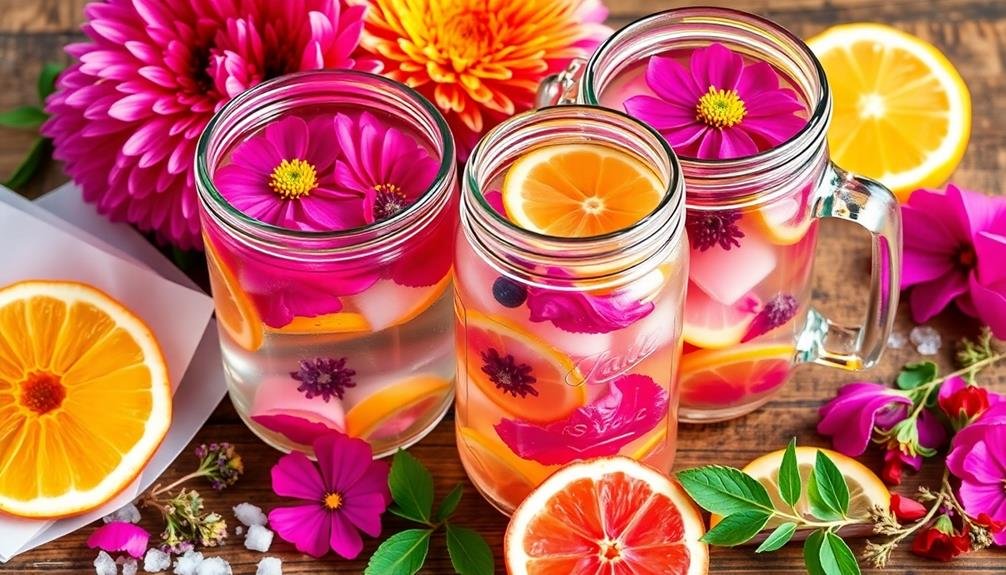
When making chrysanthemum tea fruit jellies, you'll need to decide between using fresh or dried flowers for your base.
Fresh chrysanthemum flowers offer a more vibrant flavor, while dried ones are more convenient and widely available.
You'll also want to carefully select your fruit juices, considering how their flavors will complement the floral notes of the chrysanthemum tea.
Fresh vs. Dried Flowers
Flower selection plays an essential role in making chrysanthemum tea fruit jellies. You'll need to decide between fresh and dried chrysanthemum flowers, each offering unique benefits and considerations.
Fresh chrysanthemum flowers provide a delicate, subtle flavor and vibrant appearance. They're ideal if you want a more authentic taste and visual appeal. However, they can be challenging to find year-round and have a shorter shelf life. Dried chrysanthemum flowers, on the other hand, are more readily available and have a longer shelf life. They offer a more concentrated flavor but may lack the visual impact of fresh flowers.
Here's a comparison of fresh and dried chrysanthemum flowers:
| Aspect | Fresh Flowers | Dried Flowers |
|---|---|---|
| Flavor | Delicate, subtle | Concentrated, intense |
| Availability | Seasonal | Year-round |
| Shelf Life | Short | Long |
Consider your preferences and local availability when choosing between fresh and dried flowers. If you opt for dried flowers, you'll need to adjust the quantity used in your recipe, as they're more potent than fresh ones. Experiment with both options to find the perfect balance for your chrysanthemum tea fruit jellies.
Fruit Juice Selection
Now that you've chosen your chrysanthemum flowers, it's time to select the perfect fruit juice for your jellies. Opt for clear juices that complement the delicate floral notes of chrysanthemum. Apple, white grape, and pear juices work exceptionally well, offering a subtle sweetness without overpowering the tea's flavor.
For a more vibrant taste, consider using citrus juices like lemon or yuzu. These add a revitalizing tang that balances the chrysanthemum's earthy tones. If you're feeling adventurous, try lychee or longan juice for an exotic twist.
Avoid using opaque juices like mango or papaya, as they'll cloud your jellies and mask the chrysanthemum's color. Instead, stick to translucent options that allow the tea's golden hue to shine through.
When selecting juice, always choose 100% pure, unsweetened varieties. This gives you better control over the sweetness level of your jellies.
If you can't find suitable store-bought options, consider juicing fresh fruits yourself. This guarantees the purest flavor and allows you to create unique juice blends tailored to your taste preferences.
Preparing the Chrysanthemum Tea Base
To create the foundation for these delightful jellies, you'll need to prepare a flavorful chrysanthemum tea base. Start by selecting high-quality dried chrysanthemum flowers, preferably organic. You'll need about 1/4 cup of flowers for every 2 cups of water. Bring the water to a gentle simmer in a pot, then remove it from heat. Add the chrysanthemum flowers and let them steep for 5-7 minutes. Strain the tea and set it aside to cool.
For added depth, consider infusing complementary flavors into your tea base. Here's a guide to some popular additions:
| Ingredient | Amount | Steeping Time |
|---|---|---|
| Ginger | 1 slice | 3-5 minutes |
| Honey | 1 tbsp | Stir to dissolve |
| Lemon zest | 1 tsp | 2-3 minutes |
| Jasmine | 1 tsp | 2-3 minutes |
| Mint leaves | 3-4 | 1-2 minutes |
Once you've chosen your additional flavors, add them to the strained chrysanthemum tea while it's still warm. Let the mixture cool completely before using it in your jelly recipe. This cooling process is essential, as it allows the flavors to meld and intensify, resulting in a more complex and aromatic base for your fruit jellies.
Selecting Complementary Fruits
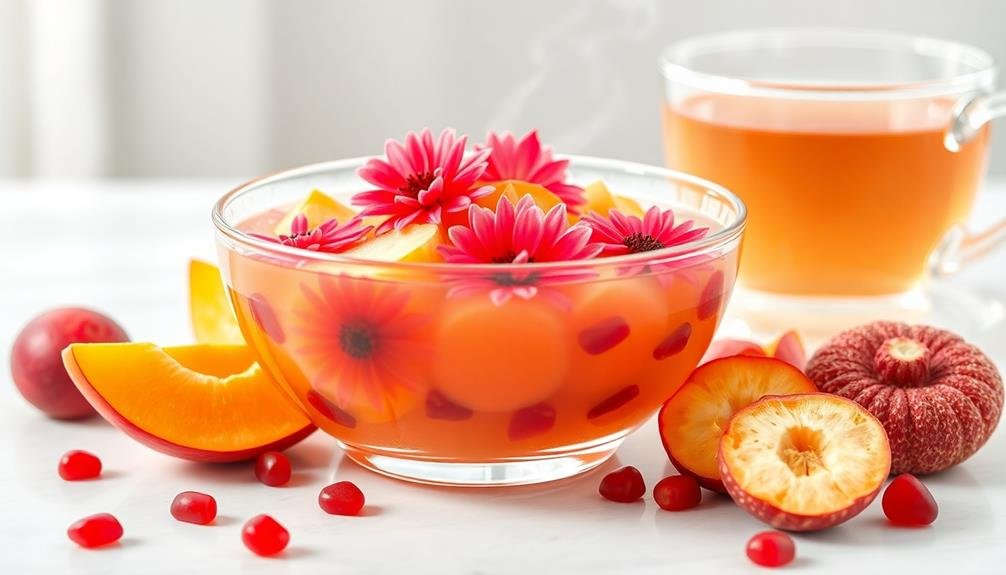
Choosing the right fruits to pair with your chrysanthemum tea base is essential for creating harmonious and delicious jellies. You'll want to select fruits that complement the delicate floral notes of the tea without overpowering them. Consider using fruits with subtle sweetness and mild acidity, such as pears, peaches, or lychees. These options will enhance the tea's flavor profile without clashing.
For a revitalizing twist, you can incorporate citrus fruits like mandarin oranges or yuzu. Their bright, tangy notes will add depth to the jellies while balancing the chrysanthemum's soothing qualities. If you're feeling adventurous, try exotic fruits like dragonfruit or longan for unique textures and flavors.
When selecting fruits, opt for ripe, in-season produce for the best taste and nutritional value. You can use fresh fruits or high-quality canned alternatives if fresh options aren't available.
Remember to cut the fruits into small, uniform pieces to guarantee even distribution throughout the jellies. By carefully choosing complementary fruits, you'll create a sophisticated dessert that showcases the chrysanthemum tea's subtle elegance while offering a delightful array of flavors and textures.
Gelatin vs. Agar-Agar
When choosing between gelatin and agar-agar for your chrysanthemum tea fruit jellies, you'll need to evaluate their key differences.
Gelatin is an animal-derived product that creates a softer, more wobbly texture, while agar-agar is plant-based and produces a firmer set.
You'll also find that gelatin sets at lower temperatures (around 35°C/95°F), whereas agar-agar requires higher temperatures (around 43°C/110°F) to solidify.
Animal vs. Plant-Based
Two key gelling agents stand out when making fruit jellies: gelatin and agar-agar. The main difference between these two is their origin. Gelatin is derived from animal collagen, typically from cow or pig bones and skin. Agar-agar, on the other hand, is a plant-based alternative extracted from red algae.
If you're vegetarian, vegan, or have dietary restrictions, agar-agar is your go-to choice. It's also suitable for kosher and halal diets. Gelatin, however, isn't appropriate for these dietary needs due to its animal origins.
In terms of texture, gelatin produces a softer, more elastic jelly that melts in your mouth. Agar-agar creates a firmer set with a cleaner bite. It's also more heat-resistant, making it ideal for desserts served in warmer environments.
When using these gelling agents, you'll notice differences in preparation. Gelatin requires blooming in cold water before dissolving in hot liquid. Agar-agar can be directly added to hot liquid and doesn't need pre-soaking.
Keep in mind that agar-agar sets at room temperature, while gelatin needs refrigeration to set properly.
Texture and Firmness
Differing considerably in their molecular structure, gelatin and agar-agar produce distinct textures in fruit jellies.
Gelatin, derived from animal collagen, creates a smooth, elastic texture that melts in your mouth. It's sensitive to temperature, setting at cooler temperatures and liquefying when warm. You'll find gelatin-based jellies have a slight bounce and a tender bite.
Agar-agar, extracted from seaweed, yields a firmer, more brittle texture. It sets at room temperature and remains stable even in warmer conditions. You'll notice agar-agar jellies have a clean break when cut and a more pronounced chew. They're ideal for layered desserts or when you need a jelly to hold its shape.
The firmness of your chrysanthemum tea fruit jellies will depend on the gelling agent you choose. If you prefer a softer, more delicate texture, opt for gelatin. For a sturdier jelly that won't melt easily, agar-agar is your best bet.
You can adjust the concentration of either agent to fine-tune the firmness to your liking. Remember, agar-agar typically requires less quantity than gelatin to achieve a similar set.
Setting Temperature Differences
The setting temperature marks a crucial difference between gelatin and agar-agar in chrysanthemum tea fruit jellies. Gelatin sets at lower temperatures, typically around 35°C (95°F), while agar-agar solidifies at higher temperatures, usually around 43°C (109°F). This distinction affects how you'll handle and mold your jellies.
When using gelatin, you'll need to work quickly once it starts cooling, as it'll begin to set relatively soon after removing it from heat. You'll have a shorter window to pour the mixture into molds or add ingredients like fruit pieces.
Conversely, agar-agar gives you more time to work with the mixture before it sets, allowing for easier layering and ingredient distribution.
The setting temperature also impacts the final texture of your chrysanthemum tea fruit jellies. Gelatin-based jellies will melt in your mouth due to their lower melting point, creating a smoother experience.
Agar-agar jellies, with their higher melting point, maintain their shape better at room temperature and offer a firmer bite.
Consider these differences when choosing between gelatin and agar-agar for your recipe, as they'll influence both your preparation process and the final dessert's characteristics.
Step-by-Step Jelly Making Process
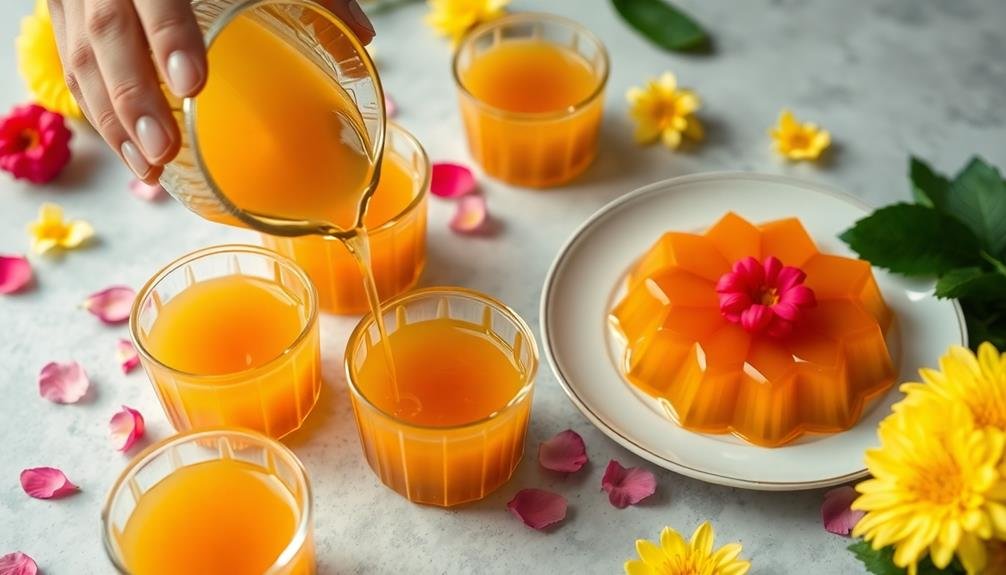
Creating chrysanthemum tea fruit jellies is a straightforward process that you can easily master at home. You'll need to gather your ingredients and equipment before starting. Make sure you have chrysanthemum tea, fresh fruits, gelatin or agar-agar, sugar, and molds ready.
Begin by brewing a strong chrysanthemum tea and sweetening it to taste. While it's still hot, dissolve your chosen gelling agent according to package instructions. Strain the mixture to remove any undissolved particles.
Pour a thin layer of the tea jelly into your molds and let it partially set. Once it's tacky, arrange your fruit pieces on top.
Here's a quick overview of the remaining steps:
- Pour the remaining jelly mixture over the fruit
- Refrigerate until fully set (usually 2-4 hours)
- Unmold carefully by dipping the molds in warm water
- Serve chilled and enjoy your elegant herbal dessert
Remember to experiment with different fruit combinations and adjust the sweetness to your liking. You can also add edible flowers or herbs for extra visual appeal.
With practice, you'll soon be creating stunning chrysanthemum tea fruit jellies that are sure to impress your guests.
Molding and Setting Techniques
When making chrysanthemum tea fruit jellies, you'll need to select suitable molds that complement your desired jelly shapes.
As you pour the liquid jelly mixture, guarantee you're using a steady hand to avoid spills and air bubbles.
For ideal setting, you'll want to refrigerate your jellies in a level, undisturbed area for the recommended time, typically 2-4 hours depending on your recipe.
Choosing Appropriate Molds
Once you've prepared your chrysanthemum tea fruit jelly mixture, it's time to contemplate the molds you'll use for shaping and setting. The right mold can elevate your jellies from simple treats to elegant confections.
Consider the occasion, serving style, and overall presentation when selecting your molds. For a traditional approach, opt for small, individual silicone molds in floral or geometric shapes. These create bite-sized jellies perfect for afternoon tea or as part of a dessert platter.
If you're aiming for a more modern look, try using larger, square or rectangular molds to create sliceable jelly blocks.
When choosing molds, keep these factors in mind:
- Material: Silicone molds are flexible and easy to unmold, while metal or glass molds may require greasing.
- Size: Smaller molds set faster but require more effort to fill, while larger molds are easier to pour but take longer to set.
- Shape: Complex shapes can be visually striking but may be challenging to unmold cleanly.
- Depth: Deeper molds create thicker jellies, which can affect texture and eating experience.
Remember to lightly grease non-silicone molds before pouring your jelly mixture to guarantee easy removal once set.
Proper Pouring Methods
With your molds selected, it's time to focus on the art of pouring your chrysanthemum tea fruit jelly mixture.
Begin by ensuring your jelly mixture is at the right temperature—not too hot to melt the molds, but warm enough to remain liquid. Gently stir the mixture to distribute any settled ingredients evenly.
Hold your mold steady with one hand and use a small ladle or pitcher with a precise spout to pour the mixture. Start slowly, aiming for the center of the mold to prevent air bubbles from forming along the sides. Fill each cavity about 90% full, allowing room for expansion as the jelly sets.
If you notice any air bubbles, gently tap the mold on a flat surface to encourage them to rise to the surface. For intricate molds, use a clean toothpick to guide the mixture into small crevices and remove any stubborn air pockets.
Work quickly but carefully to prevent the mixture from setting prematurely. Once you've filled all your molds, resist the urge to move them. Allow the jellies to set undisturbed in a cool, level place for the time specified in your recipe.
Optimal Setting Conditions
Creating the perfect setting environment is essential for your chrysanthemum tea fruit jellies to achieve the ideal texture and shape. After pouring the mixture into your chosen molds, carefully transfer them to a flat, stable surface in your refrigerator.
Verify the area is level to prevent uneven setting. The best temperature for setting is between 35°F and 40°F (2°C to 4°C).
Allow the jellies to set for at least 4 hours, though overnight chilling yields the best results. During this time, avoid disturbing the molds to prevent imperfections in the final product. If you're using silicone molds, you'll find it easier to remove the jellies once they're fully set.
To enhance your chrysanthemum tea fruit jellies' appeal and flavor, consider these additional tips:
- Experiment with layering different fruit purees for a multi-colored effect
- Add edible flowers or herb leaves to the molds before pouring for a decorative touch
- Try using shaped molds to create visually interesting jelly forms
- Sprinkle a small amount of edible gold leaf on top for an elegant finish
Once set, serve your jellies chilled for the best taste and texture experience.
Flavor Variations and Combinations
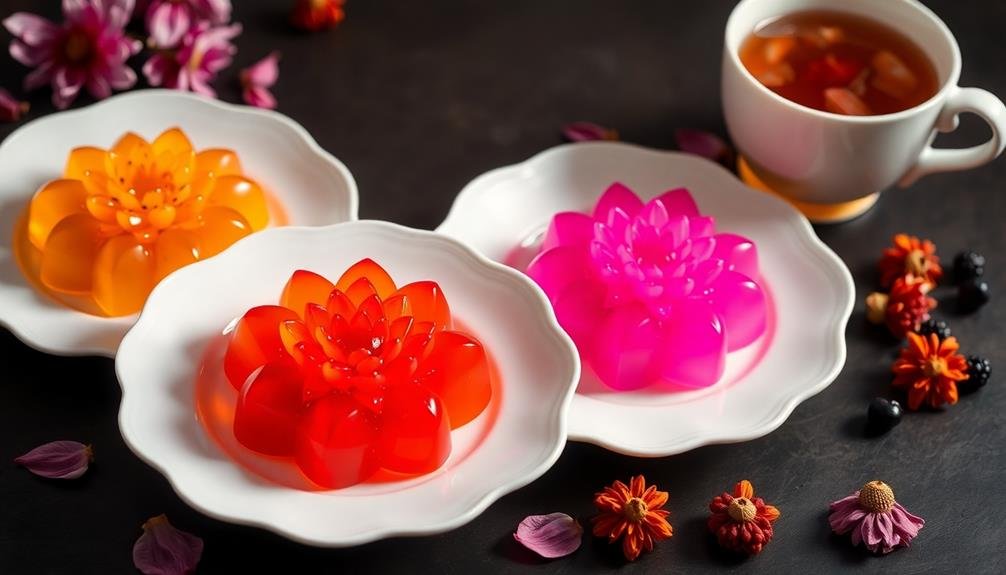
Exploring flavor variations and combinations can elevate your chrysanthemum tea fruit jellies to new heights. You'll find that the delicate floral notes of chrysanthemum pair well with a variety of fruits and complementary flavors.
Try adding citrus fruits like lemon or orange to brighten the taste and add a tangy twist. For a more complex flavor profile, incorporate honey or ginger into your jelly mixture.
If you're feeling adventurous, experiment with other edible flowers such as lavender or rose to create unique floral blends. You can also introduce herbs like mint or basil for a revitalizing twist.
For those who enjoy a bit of spice, a pinch of cinnamon or cardamom can add warmth and depth to your jellies.
Don't forget about texture variations. You can embed fresh fruit pieces, like diced peaches or berries, into your jellies for added visual appeal and a burst of flavor.
Alternatively, try layering different flavored jellies in one mold for a striking presentation.
Remember to balance flavors carefully, ensuring that the chrysanthemum tea remains the star of your creation while complementary ingredients enhance its natural beauty.
Presentation and Serving Suggestions
The presentation of your chrysanthemum tea fruit jellies can be just as important as their flavor. These delicate desserts deserve an elegant display that showcases their beauty and enhances the dining experience. Consider serving them in clear glass dishes or on white porcelain plates to highlight their vibrant colors and translucent appearance.
To elevate your presentation, try these serving suggestions:
- Garnish with edible flowers, such as fresh chrysanthemum petals or other edible blooms.
- Pair with a small scoop of vanilla ice cream or a dollop of whipped cream.
- Serve alongside a cup of warm chrysanthemum tea for a cohesive flavor experience.
- Arrange multiple jellies on a platter with fresh fruit slices for a stunning dessert display.
Don't forget to chill your jellies thoroughly before serving to guarantee they maintain their shape. You can also experiment with molds of different shapes and sizes to create visually interesting presentations.
For a more casual approach, serve the jellies in small, individual cups or jars, making them perfect for picnics or outdoor gatherings. Remember, the key is to create a presentation that complements the delicate nature of these herbal treats.
Storage and Shelf Life
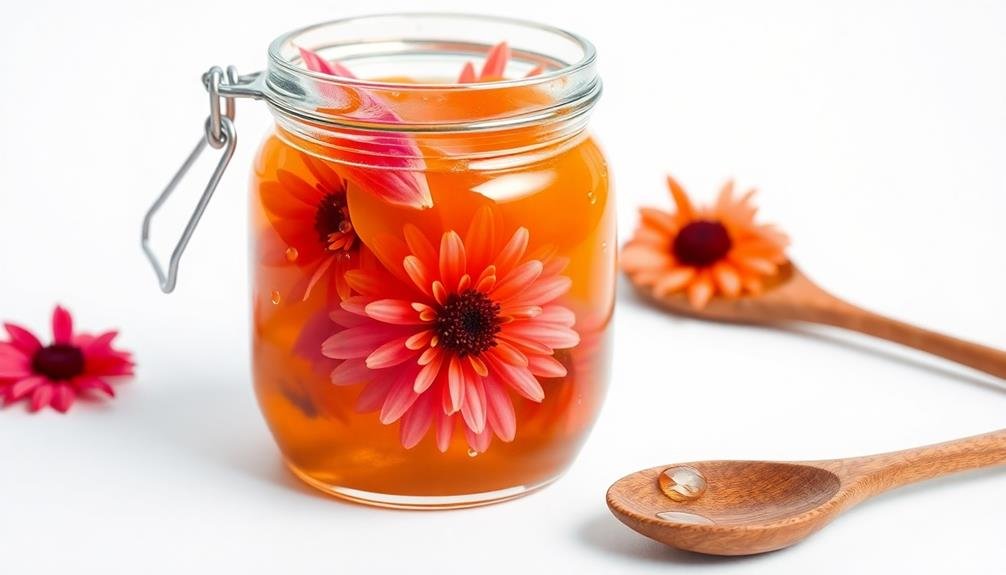
Proper storage is essential for maintaining the quality and safety of your chrysanthemum tea fruit jellies. Once you've prepared the jellies, allow them to cool completely at room temperature before storing.
Place them in an airtight container, separating layers with parchment paper to prevent sticking. Store the container in the refrigerator, where the jellies will remain fresh for up to 5-7 days.
If you've made a large batch, you can freeze the jellies for longer-term storage. Wrap each jelly individually in plastic wrap, then place them in a freezer-safe container or freezer bag. They'll keep well for up to 3 months in the freezer.
When you're ready to enjoy them, thaw the jellies in the refrigerator overnight.
For ideal flavor and texture, consume the jellies within the first 3-4 days of refrigeration. As time passes, they may lose some of their firmness and develop a slightly syrupy texture.
If you notice any signs of mold, discoloration, or off-odors, discard the jellies immediately. Always use clean utensils when serving to prevent contamination and extend the shelf life of your chrysanthemum tea fruit jellies.
Pairing With Other Desserts
Chrysanthemum tea fruit jellies aren't just a standalone treat; they can enhance various desserts and create exciting flavor combinations. These delicate, floral-infused jellies complement a wide range of sweet dishes, adding a unique twist to your dessert spread.
Consider pairing your chrysanthemum tea fruit jellies with:
- Vanilla panna cotta
- Green tea ice cream
- Almond cookies
- Fresh fruit tarts
You'll find that the subtle, herbal notes of the jellies beautifully contrast with creamy desserts like panna cotta or ice cream. The light, invigorating flavor also works well with nutty treats such as almond cookies, providing a balanced taste experience.
For a fruity explosion, serve the jellies alongside fresh fruit tarts to create a harmonious blend of flavors.
Don't hesitate to experiment with different textures and temperatures. Try layering the jellies with mousse or custard for an elegant parfait, or use them as a topping for warm puddings.
You can also incorporate the jellies into more complex desserts, such as trifles or pavlovas, to add a unique floral element. By pairing chrysanthemum tea fruit jellies with other desserts, you'll elevate your sweet offerings and impress your guests with innovative flavor combinations.
Frequently Asked Questions
Can I Use Dried Chrysanthemum Flowers Instead of Tea Bags?
Yes, you can use dried chrysanthemum flowers instead of tea bags. You'll need to steep them in hot water, then strain the liquid before using. It's a great way to get a more authentic flavor in your recipe.
Are Chrysanthemum Tea Jellies Safe for Pregnant Women to Consume?
You should consult your doctor before consuming chrysanthemum tea jellies while pregnant. While they're generally safe, it's best to err on the side of caution. Some herbal teas can affect pregnancy, so it's wise to seek professional advice.
How Can I Make Sugar-Free Chrysanthemum Tea Fruit Jellies?
You can make sugar-free chrysanthemum tea fruit jellies by using sugar substitutes like stevia or erythritol. Replace sugar with these alternatives in your recipe, and add fresh fruit puree for natural sweetness. Don't forget to adjust the liquid content accordingly.
Can I Add Alcohol to These Jellies for an Adult Version?
Yes, you can add alcohol to create an adult version of these jellies. You'll want to use a clear spirit like vodka or gin. Replace some of the liquid with your chosen alcohol, but don't overdo it.
Are There Any Cultural Significance or Traditions Associated With Chrysanthemum Desserts?
You'll find chrysanthemum desserts have deep cultural roots in East Asia. They're often enjoyed during autumn festivals and symbolize longevity. In China, you'll see them served at weddings and other celebratory events as a sign of good fortune.
In Summary
You've now mastered the art of creating elegant chrysanthemum tea fruit jellies. With their delicate floral notes and health benefits, these treats are sure to impress. Don't be afraid to experiment with different fruit combinations and presentations. They're perfect for a light dessert or afternoon tea. Remember to store them properly to maintain freshness. Whether you're serving them solo or paired with other sweets, you'll love these unique herbal jellies.

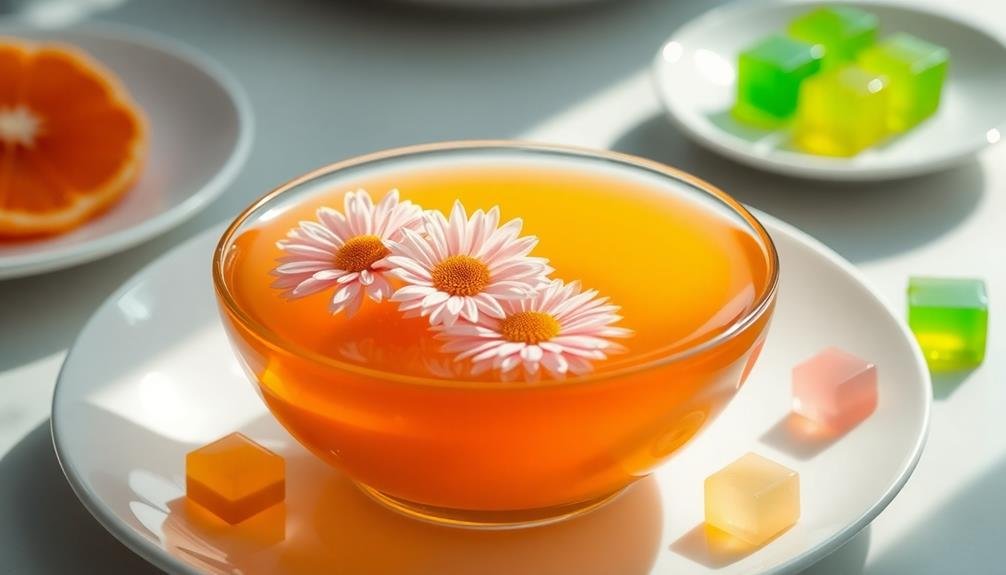
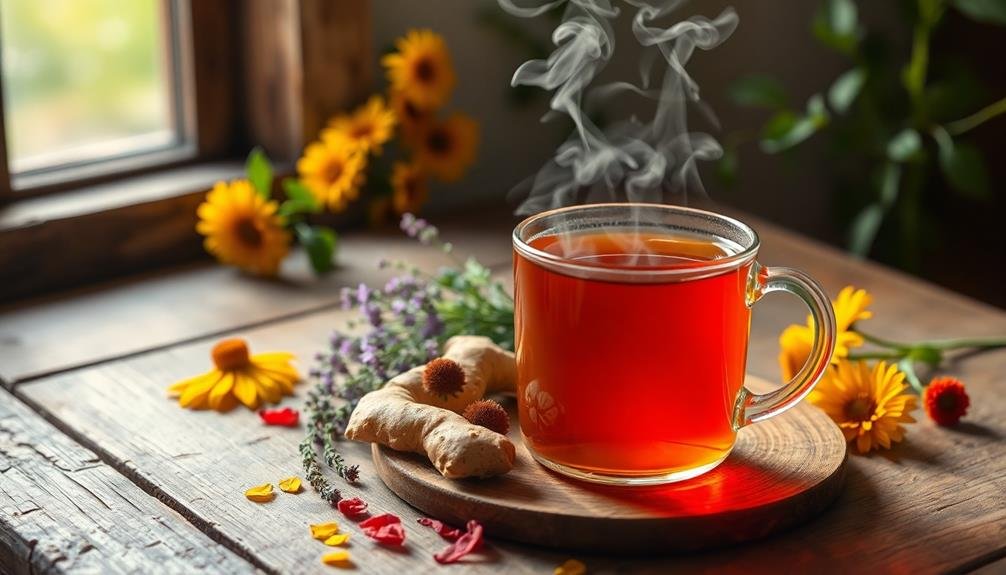
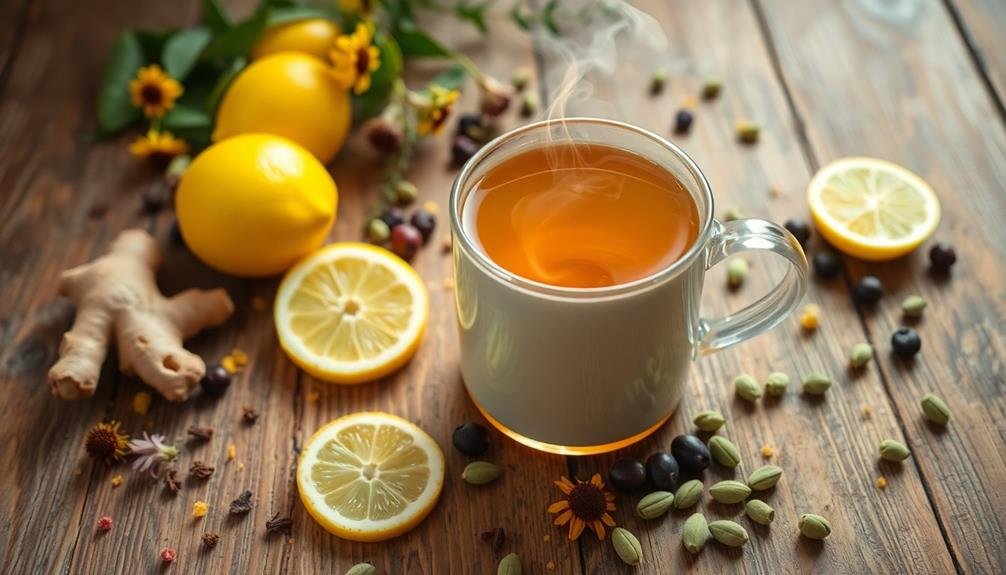
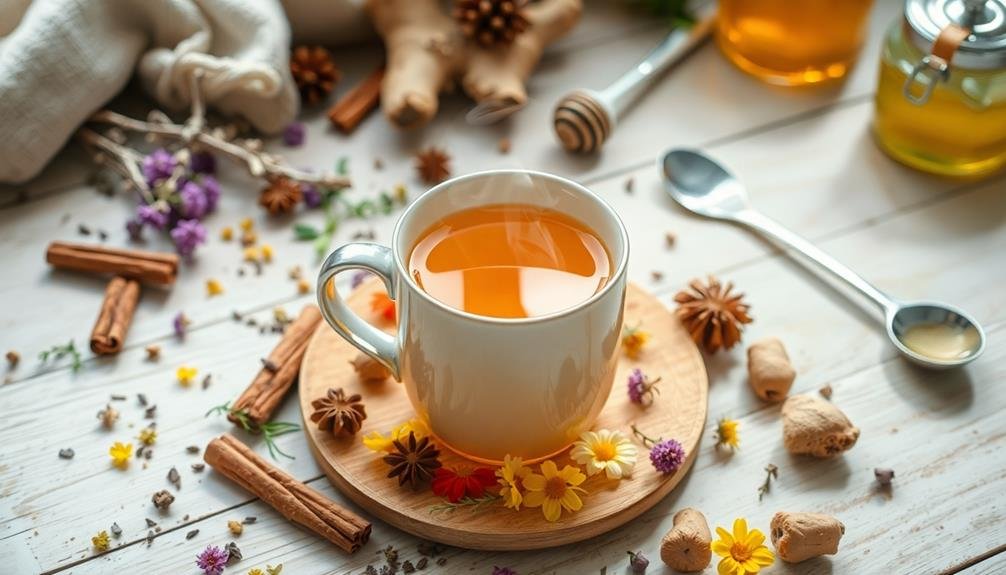
Leave a Reply